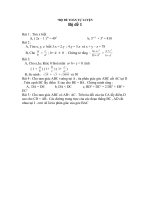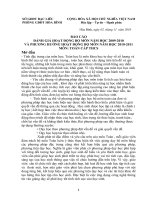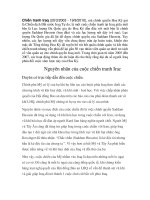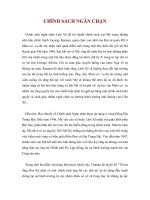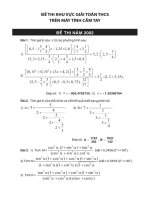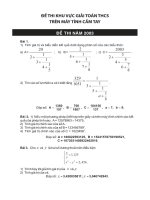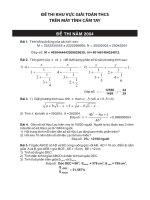packages and polygons grade 7 Bộ Sách Toán THCS Của Mỹ
Bạn đang xem bản rút gọn của tài liệu. Xem và tải ngay bản đầy đủ của tài liệu tại đây (3.37 MB, 72 trang )
Packages
and Polygons
Geometry and
Measurement
CuuDuongThanCong.com
/>
Mathematics in Context is a comprehensive curriculum for the middle grades.
It was developed in 1991 through 1997 in collaboration with the Wisconsin Center
for Education Research, School of Education, University of Wisconsin-Madison and
the Freudenthal Institute at the University of Utrecht, The Netherlands, with the
support of the National Science Foundation Grant No. 9054928.
The revision of the curriculum was carried out in 2003 through 2005, with the
support of the National Science Foundation Grant No. ESI 0137414.
National Science Foundation
Opinions expressed are those of the authors
and not necessarily those of the Foundation.
Kindt, M., Abels, M., Spence, M. S., Brinker, L.J., and Burrill, G. (2006). Packages
and polygons. In Wisconsin Center for Education Research & Freudenthal
Institute (Eds.), Mathematics in context. Chicago: Encyclopædia Britannica, Inc.
Copyright © 2006 Encyclopædia Britannica, Inc.
All rights reserved.
Printed in the United States of America.
This work is protected under current U.S. copyright laws, and the performance,
display, and other applicable uses of it are governed by those laws. Any uses not
in conformity with the U.S. copyright statute are prohibited without our express
written permission, including but not limited to duplication, adaptation, and
transmission by television or other devices or processes. For more information
regarding a license, write Encyclopædia Britannica, Inc., 331 North LaSalle Street,
Chicago, Illinois 60610.
ISBN 0-03-039632-8
1 2 3 4 5 6 073 09 08 07 06 05
CuuDuongThanCong.com
/>
The Mathematics in Context Development Team
Development 1991–1997
The initial version of Packages and Polygons was developed by Martin Kindt. It was adapted for use in
American schools by Mary S. Spence, Laura J. Brinker, and Gail Burrill.
Wisconsin Center for Education
Freudenthal Institute Staff
Research Staff
Thomas A. Romberg
Joan Daniels Pedro
Jan de Lange
Director
Assistant to the Director
Director
Gail Burrill
Margaret R. Meyer
Els Feijs
Martin van Reeuwijk
Coordinator
Coordinator
Coordinator
Coordinator
Sherian Foster
James A, Middleton
Jasmina Milinkovic
Margaret A. Pligge
Mary C. Shafer
Julia A. Shew
Aaron N. Simon
Marvin Smith
Stephanie Z. Smith
Mary S. Spence
Mieke Abels
Nina Boswinkel
Frans van Galen
Koeno Gravemeijer
Marja van den
Heuvel-Panhuizen
Jan Auke de Jong
Vincent Jonker
Ronald Keijzer
Martin Kindt
Jansie Niehaus
Nanda Querelle
Anton Roodhardt
Leen Streefland
Adri Treffers
Monica Wijers
Astrid de Wild
Project Staff
Jonathan Brendefur
Laura Brinker
James Browne
Jack Burrill
Rose Byrd
Peter Christiansen
Barbara Clarke
Doug Clarke
Beth R. Cole
Fae Dremock
Mary Ann Fix
Revision 2003–2005
The revised version of Packages and Polygons was developed by Mieke Abels and Martin Kindt.
It was adapted for use in American Schools by Gail Burrill.
Wisconsin Center for Education
Freudenthal Institute Staff
Research Staff
Thomas A. Romberg
David C. Webb
Jan de Lange
Truus Dekker
Director
Coordinator
Director
Coordinator
Gail Burrill
Margaret A. Pligge
Mieke Abels
Monica Wijers
Editorial Coordinator
Editorial Coordinator
Content Coordinator
Content Coordinator
Margaret R. Meyer
Anne Park
Bryna Rappaport
Kathleen A. Steele
Ana C. Stephens
Candace Ulmer
Jill Vettrus
Arthur Bakker
Peter Boon
Els Feijs
Dédé de Haan
Martin Kindt
Nathalie Kuijpers
Huub Nilwik
Sonia Palha
Nanda Querelle
Martin van Reeuwijk
Project Staff
Sarah Ailts
Beth R. Cole
Erin Hazlett
Teri Hedges
Karen Hoiberg
Carrie Johnson
Jean Krusi
Elaine McGrath
CuuDuongThanCong.com
/>
(c) 2006 Encyclopædia Britannica, Inc. Mathematics in Context
and the Mathematics in Context Logo are registered trademarks
of Encyclopædia Britannica, Inc.
Cover photo credits: (all) © Getty Images; (middle) © Kaz Chiba/PhotoDisc
Illustrations
1 Holly Cooper-Olds; 15, 17, 18 (top), 20 (bottom), 24 (top), 45, 47 (bottom),
52, 54 Christine McCabe/© Encyclopædia Britannica, Inc.
Photographs
14, 15 Andy Christiansen/HRW; 23 Victoria Smith/HRW; 26 © PhotoDisc/
Getty Images; 27 © Comstock, Inc.; 34 Mark Haughton; 36 © Bettmann/
Corbis; 43 (top, bottom) Sam Dudgeon/HRW; (middle) Stephanie Friedman/
HRW; 44 Victoria Smith/HRW; 46 Sam Dudgeon/HRW; 47 Andy Christiansen/
HRW; 49 (top) Sam Dudgeon/HRW; (bottom) Victoria Smith/HRW;
50 Sam Dudgeon/HRW; 53, 56 © PhotoDisc/Getty Images
CuuDuongThanCong.com
/>
Contents
Letter to the Student
Section A
Packages
Sorting Packages
Making Nets
Faces
Ne(a)t Problems
Summary
Check Your Work
Section B
23
26
27
28
29
Polyhedra
Special Polyhedra
Faces, Vertices, and Edges
Euler’s Formula
Semi-regular Polyhedra
Summary
Check Your Work
Section E
14
16
20
21
Polygons
Put a Lid on It
Pentagon
Angles
Summary
Check Your Work
Section D
1
3
8
9
10
12
Bar Models
Making Bar Models
Stable Structures
Summary
Check Your Work
Section C
vi
31
34
36
37
40
41
Volume
Candles
Finding Volume
The Height
Formulas for Volume
Summary
Check Your Work
43
45
48
49
50
51
Additional Practice
53
Answers to Check Your Work
59
Contents v
CuuDuongThanCong.com
/>
Dear Student,
Welcome to the unit Packages and Polygons.
Have you ever wondered why certain
items come in differently shaped
packages? The next time you are in a
grocery store, look at how things are
packaged. Why do you think table
salt comes in a cylindrical package?
Which packages do you think are the
most practical?
Geometric shapes are everywhere. Look at the skyline of a big city.
Can you see different shapes? Why do you think some buildings are
built using one shape and some using another?
In this unit, you will explore a variety of two- and three-dimensional
shapes and learn how they are related. You will build models of these
shapes using heavy paper, or straws and pipe cleaners, or gumdrops
and toothpicks. As you work through the unit, notice the shapes of
objects around you.
Think about how the ideas you are learning in class apply to those
shapes.
We hope you enjoy your investigations into packages and polygons.
Sincerely,
The Mathematics in Context Development Team
vi Packages and Polygons
CuuDuongThanCong.com
/>
A
Packages
Sorting Packages
José did some shopping for a surprise party for his friend Alicia.
When he got home, he put all the packages on the table. José has
many different packages and decides to sort them.
1. Discuss the ways in which you might sort José’s collection of
packages. Choose at least two different ways and show how
you would sort the collection.
Look around your home for some different-shaped packages. Select
the shapes that you find the most interesting and bring them to class.
2. Select one package from your collection or José’s collection.
Write a reason why the manufacturer chose that shape for the
package.
Section A: Packages 1
CuuDuongThanCong.com
/>
A Packages
Look carefully at the shapes of your packages. Some shapes have
special names. The models on this page highlight distinguishing
features of the different shapes.
3. Classify each package in your collection and José’s collection
according to its special name.
a. rectangular prism
e. cone
b. cube
f. truncated cone
c. cylinder
g. prism
d. sphere
h. pyramid
Models
Truncated Cones
Pyramids
Cylinders
Cones
Prisms
Rectangular Prisms
Cube
Sphere
2 Packages and Polygons
CuuDuongThanCong.com
/>
Packages A
4. Use the distinguishing features to answer these questions.
a. How are the three cylinders alike? How are they different?
b. Reflect What do you think truncated means in “truncated
cone”?
c. How are the prisms alike?
d. What are some differences between a prism and a pyramid?
e. Describe a difference between a cone and a pyramid.
Making Nets
Activity — From Package to Net
Find two packages such as a milk carton or a box.
Cut off the top of one package.
Cut along the edges of the
carton so that it stays in one
piece but can lie flat.
Cut the other package in
a different way.
Open it up and lay it flat.
The flat patterns you made from the
cartons or boxes are called nets.
•
Compare the two nets you made. Do they look
the same? If not, what is the difference?
•
Draw the two nets that you made. Make a sketch
of the solid that produces each net.
Section A: Packages 3
CuuDuongThanCong.com
/>
A Packages
Alicia decides to make a net of her box without cutting off the top.
In pictures i, ii, and iii you see the steps she took.
i.
ii.
iii. Alicia’s net
5. a. Describe how Alicia cut her box to end up with her final net.
b. The picture of Alicia’s net is drawn as its actual size. What are
the dimensions of Alicia’s box? Use a centimeter ruler for
measuring.
4 Packages and Polygons
CuuDuongThanCong.com
/>
Packages A
6. What shape would each net pictured below make if it were folded
up? If you want, you can use Student Activity Sheet 1.
b.
a.
d.
c.
e.
f.
Section A: Packages 5
CuuDuongThanCong.com
/>
A Packages
Here is a cube-shaped box without a top.
7. Which of these nets fold to make this box?
a.
b.
c.
d.
e.
f.
g.
h.
8. a. On a sheet of graph paper, trace each net that you selected for
the previous problem. On each net, shade the bottom face,
which is opposite the open top.
b. It is possible to make three more nets for the open box. Draw
at least one of these nets and shade the bottom face.
6 Packages and Polygons
CuuDuongThanCong.com
/>
Packages A
9. Explain what would happen
if you folded this net.
10. Which of the following nets can be folded to make a pyramid?
Explain.
a.
b.
c.
d.
11. a. Reflect Sandra says, “The pyramids you can make from the
above nets all have the same height.” Is this true? Why or
why not?
b. Describe how you can compare the heights of these pyramids.
Section A: Packages 7
CuuDuongThanCong.com
/>
A Packages
Faces
12. Use Student Activity Sheet 2 to make a cube. You may want to
trace the net onto heavy paper, and use that net instead.
Each flat side of a cube is called a face.
13. a. Hold the cube so that you see only one face. Draw what you
see.
b. Hold the cube so that you see exactly two faces. Draw what
you see.
c. Hold the cube so that you see exactly three faces. Draw what
you see.
d. What happens when you try to hold the cube so that you can
see four faces?
The only time you can view all faces of a shape at once is when you
view the net of that shape.
Net of Cube
Cube
All Six Faces
Visible
Only Three Faces
Visible
14. Only two faces of the prism in the picture on the left
are visible.
a. How many faces are hidden?
b. Of all faces, how many faces are triangles? How
many are rectangles?
c. Draw a net of this prism.
8 Packages and Polygons
CuuDuongThanCong.com
/>
Packages A
Ne(a)t Problems
15. a. Draw a net of a rectangular prism that is 3 inches long, 1 inch
wide, and 2 inches high.
b. Compare your net with the nets your classmates made. Are
they all the same?
16. a. Which of these nets fold into a rectangular prism?
a
b
c
b. Describe why some of the nets in part a cannot be folded into
a rectangular prism.
Here you see three nets.
a
c
b
17. a. What do these nets have in common?
b. Reflect How can you explain to someone that net A and net C
are the same?
c. A cube has 11 different nets. Try to find them all.
Section A: Packages 9
CuuDuongThanCong.com
/>
A Packages
Shapes
In this section, you studied several three-dimensional shapes. Special
names for these shapes include: cylinders, prisms, rectangular prisms,
cubes, pyramids, cones, and spheres.
You investigated features that helped you distinguish among a prism,
a pyramid, and a cone.
Nets
You made nets, two-dimensional drawings that when cut out can be
folded into three-dimensional shapes.
You made different nets for the same shape.
10 Packages and Polygons
CuuDuongThanCong.com
/>
Faces
Each flat side of a shape is called a face.
The only time you can view all faces of a shape at once is when you
view the net of that shape.
Net of Cube
Cube
All Six Faces
Visible
Only Three Faces
Visible
Section A: Packages 11
CuuDuongThanCong.com
/>
A Packages
1. Look at the pictures below. What three-dimensional shape(s) do
you recognize in each picture?
a.
b.
c.
e.
d.
h.
g.
f.
j.
i.
2. a. Select three different shapes you studied in this section. Write
down a characteristic shared by two of the shapes, but not by
the third.
b. Repeat part a with three different shapes.
12 Packages and Polygons
CuuDuongThanCong.com
/>
3. Draw a net of a rectangular prism with dimensions
4 cm ؋ 2 cm ؋ 3 cm.
Tina decorated the faces of a cube using red, white, and blue paints.
She painted opposite faces the same color. Here are six different nets
for Tina’s cubes with only some of the red faces painted.
a.
b.
c.
d.
e.
f.
4. Copy each of these nets on graph paper and mark the color of all
of the faces.
Which shapes are most commonly used for food packages? Explain
why you think these are the most often used shapes.
Section A: Packages 13
CuuDuongThanCong.com
/>
B
Bar Models
Making Bar Models
This is a bar model of a triangular prism.
You can make a bar model of a shape
using drinking straws and pipe cleaners,
toothpicks and clay, or toothpicks and
gumdrops.
•
Make a bar model of a cube.
The bars are the edges of the shape
(the line segments that form the shape).
A point at a corner where two or more
edges meet is called a vertex. (Note:
The plural of vertex is vertices.)
Edge
1. a. How many vertices and how
many edges does the bar model
above have?
Vertices
Vertex
b. How many vertices and how
many edges does your bar
model of a cube have?
14 Packages and Polygons
CuuDuongThanCong.com
/>
Bar Models B
Harold starts to make a bar model
of a rectangular prism. When he is
halfway, it looks like this:
2. On Student Activity Sheet 3, finish the bar model of Harold’s
rectangular prism by drawing the missing edges and vertices.
Tonya used a net to build this pyramid
with a square base. Here is a drawing
of her pyramid.
3. a. How many faces are in Tonya’s
pyramid?
b. Use Student Activity Sheet 3 to
change Tonya’s drawing into a
bar model, showing all the edges
and vertices.
c. Use the second drawing on Student Activity Sheet 3 to make
a bar model of a different pyramid. What is the special name
for this pyramid?
Here is Lance’s drawing of his prism.
Only three faces are visible.
4. a. How many faces are hidden?
b. How many faces are rectangles?
c. How many edges are hidden?
d. How many vertices are hidden?
e. Use Student Activity Sheet 3 to
change Lance’s drawing into a
bar model of the prism.
Section B: Bar Models 15
CuuDuongThanCong.com
/>
B Bar Models
Peter is building a bar model of a rectangular prism that is 5 cm long,
3 cm wide, and 7 cm high.
5. a. How many straws will Peter need to build the bar model of the
rectangular prism?
b. How many of each length does he need?
Yolanda wants to make a pyramid with nine edges.
6. Will she be able to make such a pyramid? Why or why not?
7. How many straws do you need to make a bar model of pyramid
with a triangular base? Make a drawing to verify your answer.
Stable Structures
Building Structures
•
Build a bar model of a pyramid with five vertices and eight
edges.
•
Build another bar model of a shape with six vertices and
nine edges.
8. a. Which of the structures you made is more stable? How does
the number of triangular faces affect the stability of the
structure?
b. What could you do to make the other structure more stable?
c. Is it possible to build a structure with nine vertices and five
edges? Explain.
16 Packages and Polygons
CuuDuongThanCong.com
/>
Bar Models B
To make a frame rigid, designers use triangles to
add strength and stability to the frame.
Theo designed this bookcase with three shelves.
9 a. Do you think this is a good design? Why or
why not?
b. Improve Theo’s design by adding one piece
of wood. Make a sketch of your improved
bookcase.
10. Which bar model is more stable: a triangular prism or a cube?
Why do you think so?
You can make the structure of a cube
more stable by adding an extra bar.
Here is an example of a face diagonal.
This face diagonal is an extra bar on
the face, connecting two vertices that
are not next to each other.
In this cube, two face diagonals
are shown.
11. How many different face
diagonals are possible for
any cube?
Section B: Bar Models 17
CuuDuongThanCong.com
/>
Stable Cubes
•
Use the bar model of the cube you made in the activity on
page 14.
•
Add the minimum number of face diagonals to make the cube
stable.
Another type of diagonal to consider is called the space diagonal.
The space diagonal goes through the inside or space of the cube,
connecting two vertices.
It does not lie on any of the faces. In this drawing, the extra bar connects
a vertex the upper back down to the vertex on the front bottom.
12. How many space diagonals does a cube have? Show them all on
Student Activity Sheet 4.
13. Which of the shapes on page 2 do not have face diagonals?
Which of the shapes on page 2 do not have space diagonals?
14. Name each shape and find the number of face diagonals and the
number of space diagonals.
a
b
c
18 Packages and Polygons
CuuDuongThanCong.com
/>
Bar Models B
Math History
Mankind has made efforts to design three-dimensional puzzles.
One of the most successful is the Soma Cube, invented by Piet Hein.
The Soma Cube is sometimes regarded as the three-dimensional
equivalent of a tangram. Both types of puzzles are made up of seven
pieces, and they can both be used to construct numerous shapes.
Tangram
Two-dimensional:
Soma Cube
Three-dimensional:
All seven of the following pieces
together can form a 3 ؋ 3 ؋ 3 cube.
Can you figure out how they can be
put together to form a cube?
Section B: Bar Models 19
CuuDuongThanCong.com
/>

